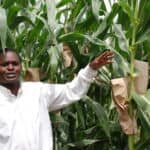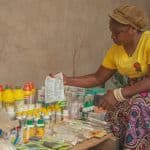Bringing Agricultural Insurance to Climate-Vulnerable Farmers: A Unique Pilot Program in Nepal Shows How to Unlock the Benefits of Index-Based Insurance for Smallholders
Nepal is uniquely vulnerable to natural disasters, including climatic ones like floods and droughts, and non-climatic ones like earthquakes and epidemics. Located in the centre of the Himalayas, its topography and climatic conditions make it one of the most disaster-prone countries in the world.
These disasters not only cause the loss of lives and property, they also pose severe threats to physical infrastructure and disrupt economic development. And addressing them will be costly: It is estimated that achieving Sustainable Development Goal (SDG) 13 (climate action) in Nepal will require US $47.4 billion for climate adaptation and $196.1 billion for climate mitigation between 2021 and 2050.
Making matters worse, the impacts of Nepal’s climate variability and extreme weather events are unevenly distributed among its people, with smallholder farmers and rural women disproportionately affected. It’s also a country where a climate-sensitive industry — agriculture — represents 24% of the GDP and employs 64% of the labour force (and 74% of the female labour force). Due to these circumstances, and considering that Nepal’s government is committed to achieving not only SDG 13 but also SDG 2 (food security) and SDG 5 (gender equality), the development of risk management tools for farmers is an imperative priority for the country.
The government of Nepal has put a particular emphasis on the importance of investing both in financial inclusion for smallholder farmers and in risk management tools that help them cope with climate-related threats. For example, Beema Samiti – the Nepal Insurance Authority – requires at least 5% of the total insurance policies sold by non-life insurance companies to be for agriculture, livestock and produce. The federal government provides a 75% subsidy on the insurance premium, which has helped to insure almost $24 million worth of agricultural products. However, insurance companies have leveraged this subsidy more for livestock than for other types of products, as claim settlement is easier to manage in this case. This excludes many farmers whose crops and livelihoods are essential to the food security and economic growth of the country.
Below, I’ll discuss a UN Capital Development Fund (UNCDF) pilot program that leveraged local partnerships, technical assistance, farmer training and an innovative product design to bring agricultural insurance coverage to Nepali smallholders. Though the program, which ended in 2021, was focused on the unique needs of Nepal, the learnings it generated could help inform efforts to expand the benefits of insurance to farmers in other climate-vulnerable countries in Asia and beyond.
Understanding the Different Types of Agricultural Insurance
Globally, there are several types of agricultural insurance, which include traditional indemnity-based insurance and index-based insurance.
Indemnity-based insurance typically protects against physical losses, and payouts are made after damage assessments are carried out. These damage assessments are difficult and time-consuming to execute in remote rural areas, while smallholder farmers — particularly women — often need their insurance payouts right away due to the demands of the crop cycle. As a result, indemnity-based insurance is more suitable for wealthier customers, who have enough cash on hand to cover their expenses while this assessment process plays out. It has proven not to be responsive to the needs of smallholders and others who are most affected by climate risks. What’s more, the concept of insurance in general is often challenging to explain to these customers, since the products are complex, and the financial literacy of these potential clients is usually low. These factors may partially explain why the penetration rate of agricultural insurance in Nepal — where most such products are indemnity-based — is around 1%.
Index-based insurance involves payouts that are triggered and calculated by historical data and a pre-determined index, which also determines the amount of the benefits. A yield index-based insurance — one of several types of index insurance — covers all risks that may affect the crop yield in a determined area, and the more farmers in that specific area who participate in the coverage, the less they each pay for the insurance premium. For example, the index may use historical data to project the expected amount of rainfall in a specific area, and to calculate the value of the insured yield. If the level of rainfall is lower or higher than the one predicted by the index, then payouts to the farmers can be triggered with no need for a lengthy verification process by the insurer. The straightforward design of the product itself makes it easy to understand, enhances transparency, helps to avoid disputes and may reduce costs for farmers.
Piloting a Yield Index Insurance Designed for Farmers in Nepal
To bring the benefits of index insurance to more Nepali farmers, UNCDF made a catalytic grant, coupled with technical assistance, to Jeevan Bikas Laghubitta Bittiya Sanstha Limited (Jeevan Bikas), a local microfinance institution, and Pula, a global insurance technology company. Through this support, we enabled these companies to pilot an area yield index insurance for smallholder farmers in the Morang district of Province 1 in eastern Nepal. The grant was used to:
- Unlock a government subsidy designed to offer insurance to smallholder farmers;
- Provide technical assistance to Jeevan Bikas on the design and roll-out of the product; and
- Build the financial capabilities of the farmers.
UNCDF helped Pula to design the insurance product together with Nepali insurance companies, in close cooperation with Beema Samiti and other stakeholders. We facilitated the approval of the insurance by Beema Samiti, and held discussions about premium subsidies with the Ministry of Agriculture and Livestock Development. We also organised a learning dissemination workshop on the area yield index insurance with non-life insurance companies in Nepal, explaining what these insurers would need to focus on to offer similar kinds of products.
To date, these efforts have enabled 15,380 smallholder farmers in the district, primarily low-income rural women, to receive insurance coverage to protect their rice yields against frost, excessive rainfall, heatwaves, hail, flood, drought, pests and diseases. The estimated total sum insured for these rice farmers was $4,000,000, which is equivalent to around $260 per farmer. About 70,000 smallholder farmers received training on the insurance product, which was delivered digitally, and 10,000 farmers received advice on agricultural agronomy.
Critical Factors for Successful Agricultural Insurance Products
In implementing this grant program, we identified several factors that are critical to the success of an agricultural insurance offering, which I’ll discuss below.
- Building the capacity of local financial institutions to design and pilot the insurance product: Although Jeevan Bikas is one of the largest microfinance institutions in Nepal, it needed new technical capabilities to develop and pilot index-based insurance. The technical assistance provided by Pula, highlighted below, was pivotal to the success of the product, helping Jeevan Bikas to:
- Identify the average production history in the insured area, and the unit area of insurance (i.e., the unit of measurement that’s used to determine the amount of cultivated land covered by the insurance);
- Determine if the yields of the farmers were lower than the historical benchmark, based on a sampling methodology;
- Establish key product attributes like the basis for determining coverage amounts, the average sum insured per farmer, and the point at which payouts are triggered;
- Define the payout amount based on the yield benchmarks vs. the yield attained;
- Collect data from a representative sample of farmers after harvest, to determine the average yields and payouts for each unit area of insurance.
- Leveraging partnerships to crowd in finance from the private sector and promote uptake of area yield index insurance: As the largest area yield index insurance ever offered in Nepal, this program required multi-stakeholder partnerships, and commitment from both the private and public sectors. UNCDF, as a neutral broker of partnerships, is proud to have facilitated these interactions and helped the stakeholders navigate these relationships. Thanks to this project and our collaboration with Beema Samiti, Jeevan Bikas and Pula, offering yield index insurance products to smallholder farmers is now more feasible for financial service providers in Nepal. Beema Samiti and the local insurers it worked with for reinsurance were initially reluctant to participate in the area yield index insurance. There was no history of cross-border agricultural underwriting in Nepal and, at first, Pula’s reinsurance partners did not want to take on the risks. Through the close engagement we helped foster with these reinsurance partners, we were able to highlight the product’s potential to reach new markets in a cost-efficient manner. Similarly, our close engagement with Beema Samiti allowed UNCDF and our partners to familiarise the regulator with index-based insurance and its benefits.
- Empowering smallholder farmers with knowledge about agricultural insurance: Smallholder farmers often lack an understanding of agricultural insurance, which represents one of the biggest barriers to the product’s uptake. Focus group discussions conducted as part of the project showed that the farmers we were targeting shared this low level of awareness of agricultural insurance, including crop insurance, livestock insurance and area yield index insurance. Many also did not know about the government subsidy offered in Nepal, which (as mentioned above) covers 75% of the premium for agricultural insurance. The training we designed aimed to clarify the benefits of the product to farmers, and to explain how they could access and claim the insurance, in order to address key gaps in the knowledge, skills and attitudes of these potential clients.
Designing Sustainable, Scalable Agricultural Insurance Products in Emerging Markets
Our pilot project leveraged a government subsidy, but Nepal is on its way to graduating from its least developed country status, which will result in decreasing official development assistance. In this context, it is critical that financial service providers find a way to deliver and scale up agricultural insurance products in a more sustainable manner. Below are some suggestions for how they can make this happen.
- Product refinement: Our focus group discussions with the farmers were key to understanding their challenges and to better delivering the insurance product. The data collected during the pilot helped to improve the future payout structure of the product, which will provide farmers with insurance payouts if their actual yields fall below 70% of their average production yields, paying them up to 70% of the insured value of their yields.
- Use of digital solutions: The pilot project used digital technologies to deliver training to the farmers, and UNCDF sees a clear opportunity to use digital innovation to scale up the uptake of this type of insurance. For example, digitization can reduce the cost of distribution and transactions, provide farmers the flexibility and convenience of making premium payments using mobile money, and ease the claim process by allowing farmers to submit documents as digital photographs instead of physical copies. Through these and other benefits, digital technology can act as a catalytic enabler to the delivery of index-based agricultural insurance in Nepal and other low- and middle-income markets.
- Regulatory framework: It is important that financial service providers bundle area yield index insurance with other services such as loans and savings. This will make the product easier to deliver for a financial institution, which in turn will increase the uptake of the insurance. The right regulatory framework, however, needs to be in place to allow providers this type of flexibility.
This pilot program demonstrates the critical role of financial services in protecting development gains and giving farmers the best chance to mitigate the risks of extreme weather events. UNCDF will continue to work with the government of Nepal and our other partners in piloting and scaling financial mechanisms that provide meaningful change to the most vulnerable. We are also keen to work with other stakeholders in the broader Asian region to take this agenda forward and share our learnings. If you’d like to learn more about this work, contact Georgii Nikolaenko, UNCDF’s Learning, Knowledge Management and Communications Analyst, at georgii.nikolaenko@uncdf.org
Maria Perdomo is the Regional Coordinator for Asia at UNCDF.
Photo courtesy of UN Women.
- Categories
- Agriculture, Environment, Finance



